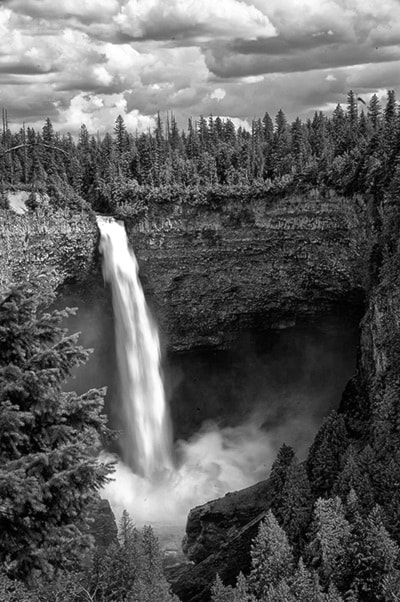A local photographer showed up at my shop with some scenic/landscape photographs he had made and asked me for a critique of them.
Photographers get excited about the subjects they photograph and sometimes forget, or never learned, some basic rules for photography, but really, these rules are actually procedures and guidelines that can be followed to make photographs more exciting for viewing.
Although I enjoyed his series of photographs of Helmcken Falls in Wells Gray, I noticed two problems that I discussed with him.
The first is a very basic concept in photography – depth of field. Depth of field refers to the “in focus area,” or sharpness of a picture at different distances when the aperture diameter changes. Depth of field is the area around the subject that remains acceptably sharp. The farther things are away, the more depth of field one can achieve, and the closer things are, the less depth of field. To control depth of field one uses the lens aperture.
Photographers new to this medium think of the aperture only as a means of controlling the amount of light reaching the sensor, but the aperture also controls depth of field.
Control over depth of field is accomplished by increasing or decreasing the aperture’s size. For example, the smaller the aperture opening (f/16) the more depth of field; and the larger the aperture opening (f/4) the less the depth of field is. So f/16 will give more “in focus area” in front of and behind the subject than f/8.
Regardless of the F/stop one should have a shorter in focus area in front of the subject, and a longer in focus area behind the subject. The ratio is approximately one-third in front, and two-thirds behind. So to obtain maximum depth of field in a photograph use a smaller aperture opening like f/11, and focus one third of the way into the scene.
The second thing I pointed out was his composition. I wondered what it is that makes photographers disregard the basics of compositional strategies and just snap away excitedly?
My assumption is that many photographers are so excited about the subject they are photographing, and possibly the camera they are using at the time, that they forget to make the subject interesting in their final photograph.
With his scenics of the water fall, as exotic and colourful as it was on that day, he ignored something fundamental in any properly composed photograph called “The Rule of Thirds”.
This so called “rule” states that we shouldn’t place the main focus of interest in the centre of the frame, but should place it on an intersection line, or very close to it, created by dividing the picture into a grid of thirds.
That photographer’s pictures would have been stronger if he had paid attention to compositional elements that would make his image interesting by placing important or interesting visual information at intersections.
I have photographed those falls alongside other photographers many times since I moved to British Columbia 40 years ago; spring, summer, fall and winter. Sometimes they have been excited, as with the fellow I critiqued, and just pointed their cameras without thought, overwhelmed by the roaring, wilderness splendour of Helmcken Falls.
Regarding those image makers, Guggenheim Fellowship for Creative Arts recipient Garry Winogand quipped, “Photographers mistake the emotion they feel while taking the photo as a judgment that the photograph is good”.
However, I have also set my tripod next to photographers that just seemed to understand what it takes to make viewable images and appear to feel their way through the photograph. That’s always exciting.
Of them I like to think they adhere to the words of Photo Imaging Association’s 2005 Photographer of the Year, David Harvey when he said, “Don’t shoot what it looks like. Shoot what it feels like.”
These are my thoughts this week. Contact me at www.enmanscamera.com or emcam@telus.net. Stop by Enman’s Camera at 423 Tranquille Road in Kamloops. And if you want an experienced photographer please call me at 250-371-3069. I also sell an interesting selection of used photographic equipment.
